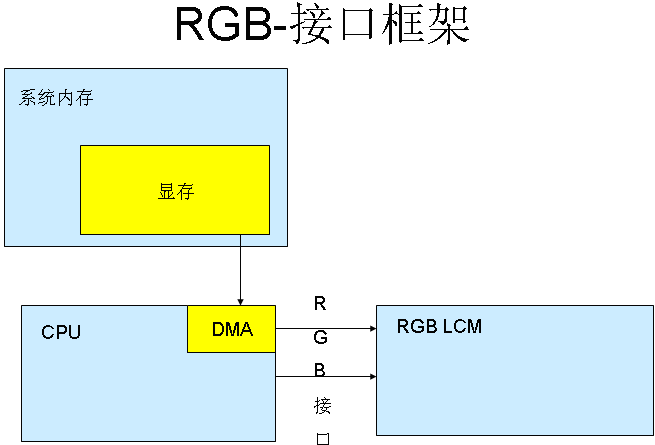
The main difference between MCU-LCD and RGB-LCD screens lies in the location of the video memory:
The video memory for RGB-LCD is served by the system memory, so its size is only limited by the size of the system memory. This allows RGB-LCD to produce larger sizes; for instance, the current 4.3 inches can only be considered entry-level, while 7 and 10 inches are increasingly used in MIDs.
MCU-LCD was designed with the understanding that microcontrollers have smaller memory, so video memory is built into the LCD module. The software updates the video memory through specific display commands, which means MCU screens often cannot be made very large. Additionally, the display update speed is slower than that of RGB-LCD.


The data transmission modes between MCU-LCD and RGB-LCD also differ:
For RGB screens, the video memory needs to be organized properly. Once the display is started, the LCD-DMA automatically sends the video memory to the LCM via the RGB interface.
In contrast, MCU screens require sending commands to modify the internal RAM of the MCU (i.e., you cannot directly access the RAM of the MCU screen). Therefore, the display speed of RGB is significantly faster than that of MCU, and when it comes to playing videos, MCU-LCD is also relatively slow.
For RGB interface LCMs, the host directly outputs the RGB data for each pixel without needing conversion (except for GAMMA correction, etc.). For such interfaces, an LCD controller is needed in the host to generate RGB data and synchronize signals for pixels, rows, and frames.
In other words, traditional MCU screens write display data into DDRAM, whereas RGB screens do not write data into DDRAM but write directly to the screen, resulting in faster read/write speeds.
Source: | Jishu Community
This article is reproduced from the internet, and Electronic Engineering Magazine maintains neutrality regarding the viewpoints expressed in the text. It is for learning and communication purposes only; if there is any infringement, please contact us for removal.


Upload videos to receive cash rewards ranging from 5 to 100 yuan. High-quality video creators can also receive a beautiful gift.
Video Requirements:
1. Original video;
2. Content related to the electronics industry; (whether it is an explanation of electronic technology knowledge, technical applications, design examples, market analysis, etc.)
3. When publishing the video, please add #芯视频# to the title, which will be considered as participation in this event;
We will promote your video to let more people see it:
1. All videos will receive promotional exposure;
2. Outstanding videos can receive exclusive advertising space;
3. High-quality videos can also receive significant traffic (10,000 to 100,000 exposures) promotional support.
Beautiful Gifts (First come, first served):
High-quality video creators can choose from beautiful gifts, with varying quantities available on a first-come, first-served basis.

Scan to access Chip Video directly
